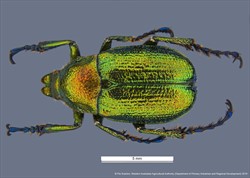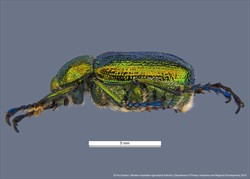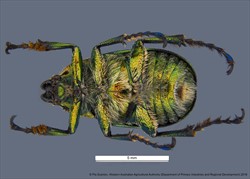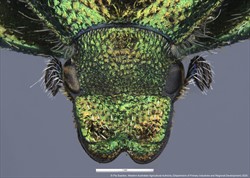Sub family: Melolonthinae / Tribe: Diphucephalini / Genus: Diphucephala
Fact Sheet
Diphucephala Dejean, 1821
Small, oblong shaped beetles. Body length 4-10mm, body colouration metallic green, blue or cupreous. Labrum extended in front of clypeus, visible from above, fused with clypeus but separable by transverse ridge or declivity, or rarely by lateral traces of a suture. Circular fovea (pit) present near lateral edge of the pronotal disc. Elytra punctate, arranged in rows. Ventral body surfaces covered in flattened white setae. Claws bifid, and 0-2 apical spurs on the metatibia, placed below tarsal articulation.
Very little has been recorded for the biology of most species of Diphucephala. Species have been observed feeding on native yellow flowering flora, especially Acacia. Other species have been observed feeding on the leaves of trees and occasionally swarming on grape vines and bean plants. D. colaspidoides beetles have been recorded on pome and stone fruit foliage in SA, while its larvae have been recorded from Tasmanian pastures. D. lineata have been recorded causing defoliation of Melaleuca.
The genus Diphucephala is found right across the lower half of Australia, from South-West WA to Tasmania, and then northwards into Far-North Queensland. It is absent from the Northern Territory and North-West WA.
Brisbane Insects- in-Life photographs: https://www.brisbaneinsects.com/brisbane_scarabs/GreenScarab.htm
Britton, E.B. 1995. A synopsis of the Genera of Diphucephalini (Coleoptera : Scarabaeidae : Melolonthinae) including Watkinsia gen. nov. et spp. nov. Invertebrate Taxonomy 9(1): 115-128
Hely P.C., Pasfield G., Gellatley G.J. 1982. Insect Pests of Fruit and Vegetables in New South Wales. Inkata Press, Melbourne. pp.312







